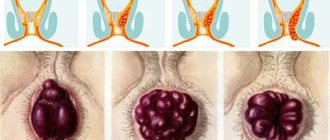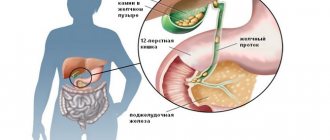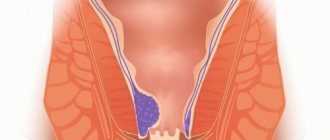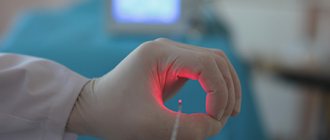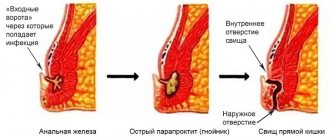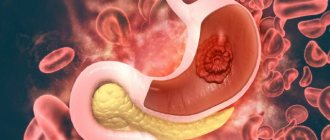Hemorrhoids are a vascular disease that is characterized by varicose veins of the anus and rectum with the formation of hemorrhoids that are prone to inflammation and prolapse.
The disease is one of the most common vascular pathologies, affecting up to 10% of the world's population, and among proctological diseases, hemorrhoids are the undisputed leader. In its development, the disease goes through several stages. Stage three hemorrhoids are a serious pathology that requires immediate treatment and often leads to serious complications. The transition of the disease to the third stage occurs for several reasons, the main of which are poor-quality therapy for the initial stage of the disease, or its absence.
Chronic hemorrhoids 3 degrees
If a person suffering from hemorrhoidal disease does not consult a doctor or does not follow the recommendations given to him, the chronic course of hemorrhoids steadily leads him to the third stage of the disease. Signs of pathology periodically worsen, cause discomfort, reduce quality of life, and require surgical intervention.
Chronic internal hemorrhoids stage 3 with transition to the fourth are the result of a neglectful attitude towards one’s health in the initial stages of the disease.
Hemorrhoids never appear out of nowhere, therefore the location of inflamed hemorrhoids is similar to stages 1 and 2 of the disease:
- rectum, rectum inside;
- external or external - around the anus;
- combined.
The third stage of hemorrhoidal disease is a period of complications that poses a danger to human health and life. Patients require urgent consultation with a proctologist, otherwise there is a risk of transition to critical stage 4 of the disease, when surgical intervention may not be enough to correct the dangerous condition.
Prevention and prognosis for the patient
Patients at risk of developing hemorrhoids and patients with an existing disease should adhere to the rules for preventing the disease and its complications. To do this, it is recommended to adhere to a healthy diet, give up bad habits, play sports, and promptly treat diseases of the gastrointestinal tract. You cannot lift weights, restrain the urge to defecate, or sit on the toilet for a long time.
If preventive measures are followed and the disease is diagnosed in a timely manner, the prognosis for the patient is quite favorable. Competent therapy and elimination of factors that provoke hemorrhoids will help maintain health for many years.
Main symptoms
The clinical symptoms of the third stage are characterized by the same signs as hemorrhoids in the initial stages of their development, only the symptoms are pronounced due to the size of the nodes, their number and the degree of inflammation.
Internal hemorrhoids stage 3
The main difference between rectal pathology of this period is the prolapse of hemorrhoids with any effort without self-reduction into place.
The reason is dystrophic changes in the venous blood flow system of the anorectal region, combined with weakness of the muscles and ligaments of the anus. Due to the large size of hemorrhoidal formations, the deformed muscles of the rectum become unable to support varicose veins, so they can only be reduced with the help of hands. Reduction is necessary, since in the rectum cavity they are more reliably protected from injury and strangulation.
In addition, many people notice:
- severe itching and burning in the perianal
area before and after defecation, as well as during prolonged sitting; - inflammatory exudate from the rectum
irritates nearby tissues with symptoms of dermatitis or eczema, cracks form, proctitis and paraproctitis occur; - pain during bowel movements
becomes too strong and requires the use of medications; - hemorrhoids are constantly touched up
.
The symptoms are so pronounced that the person’s ability to work is impaired, and he is forced to seek help from a proctologist.
External hemorrhoids 3rd degree
It is characterized by all the symptoms of internal hemorrhoids, with the exception of prolapse of nodes. But there are also some peculiarities:
- cavernous formations grow in volume, their skin becomes thin, so with any careless movement or straining during defecation, local bleeding opens, which is noticeable by marks on toilet paper;
- bleeding is accompanied by pain, which increases with coughing and sneezing;
- the nodes thrombose
, the pain can be unbearable; - a feeling of a foreign body
in the anus ; - irritation of the perianal area causes the appearance of anal fissures, and there is a risk of secondary infection, suppuration, and ascending infection in the pelvic organs.
Hemorrhoids can be felt independently in the form of lumps surrounding the anus.
Treatment of the disease
Treatment of hemorrhoids in the initial stages of the disease can be conservative, when the patient’s condition can be improved with the help of medications. The third stage of hemorrhoids indicates serious circulatory problems in the rectum and anus, therefore radical treatment methods are required. Enlarged hemorrhoids due to their significant size must be removed surgically. Hemorrhoidectomy is performed both classically, using a scalpel, and using a laser. In some cases, a combined operation is performed - excision of the node using a laser and subsequent sclerosis of a nearby vessel.
Surgical treatment is not a 100% guarantee of complete cure without maintenance drug therapy, lifestyle adjustments, diet, increased physical activity and giving up bad habits. Only an integrated approach will allow you to achieve high-quality and long-term positive treatment results.
On the medical basis, diagnosis and treatment of all forms of hemorrhoids are carried out using modern methods of therapy in proctology. Modern diagnostic equipment and specialists with many years of experience guarantee impeccable treatment results.
You no longer need to endure pain and experience constant discomfort. Contact a multidisciplinary medical center and our specialists will solve your delicate problems as quickly, tactfully and painlessly as possible. You can make an appointment by phone: +7 or using the online registration form on the website.
The danger of stage 3 hemorrhoidal disease
Ignoring the symptoms of hemorrhoids leads to the development of serious complications that threaten a person’s life:
- secondary infection with the development of erosions, ulcers, fistulas, abscess formation of anorectal tissue, the risk of developing sepsis;
- bleeding causing anemia;
- thrombosis of nodes with severe pain, microinfarctions of the pelvic organs due to impaired microcirculation;
- strangulation - involuntary confluence of cavities can provoke a sensitive anal valve to contract, which will cause spasm of the anus and strangulation of the hemorrhoid with pain syndrome up to fainting;
- necrosis is a consequence of thrombosis or strangulation with the development of blood stasis in the venous plexuses, the occurrence of inflammation, secondary infection, death of the mucous membrane, suppuration, and sepsis.
Chronic and severe combined hemorrhoids of stage 3 are an extremely dangerous condition, precisely because of the risk of lethal complications, contacting a proctologist is vital.
Causes of pathology
Third degree hemorrhoids develop as a complication due to lack of treatment in the previous stages or due to improper treatment of the disease. Aggravating factors include:
- poor nutrition;
- diseases of the digestive system, accompanied by constipation and flatulence;
- sedentary work, lack of physical activity;
- work activity associated with lifting weights;
- strength training;
- pregnancy, childbirth.
These problems provoke poor circulation in the pelvic organs and congestive processes. As a result, the outflow from the veins of the rectum is greatly impaired, the vessels become overfilled with blood, stretch, become deformed, and the functioning of the venous valves is disrupted.
Diagnostics
The algorithm for examining a patient with hemorrhoids is standard:
- history taking, visual examination, digital examination of the rectum (sometimes the patient may be asked to cough to assess the condition of the nodes, the degree of bleeding, the possibility of reduction);
- OAC, OAM – assessment of the patient’s general condition;
- feces for occult blood, so as not to miss latent bleeding;
- coprogram – balance of intestinal microflora;
- anoscopy – examination of the rectum to a depth of 15 cm;
- sigmoidoscopy – visualization of the mucous membrane up to 30 cm from the anus;
- colonoscopy - assessment of the condition of the entire large intestine, performed with local anesthesia or general anesthesia;
- irrigoscopy - contrast x-ray of the intestine.
If a tumor process is suspected, a biopsy with histological examination for atypia is performed.
What happens if you don’t see a doctor in time?
The third stage of hemorrhoids is a serious disease that requires immediate assistance from specialists. The lack of qualified treatment leads to complications, transition to the most complex, life-threatening form - the fourth. The last stage of hemorrhoids is treated exclusively by surgery.
- The presence of cracks in the anus opens the door for pathogens to enter the intestines. Inflammation progresses, mucus and pus begin to be released, accompanied by an unpleasant odor.
- Loss of sphincter elasticity leads to uncontrolled release of feces. Irritation of the rectal mucosa occurs, ulcers, erosions, and wounds appear. The passage of feces during defecation provokes bleeding of varying intensity.
- Loss of nodes is dangerous due to strangulation, thrombosis, and tissue necrosis. This situation requires emergency surgical intervention.
Treatment of grade 3 hemorrhoids without surgery: list of drugs
Hemorrhoids of the third, penultimate stage of severity cannot be cured with medications. The drugs are used to relieve pain, facilitate defecation, during the preparation of the patient for surgery and after it, during the rehabilitation period. This is an auxiliary treatment method. You cannot rely on it, since without surgery such treatment can lead to progression of the disease, transition to the criminal stage 4, and the development of complications.
It should be noted that conservative therapy can be used at home; the medications are convenient to take orally or externally, act quickly, relieving negative symptoms. The list of main medications used at stage 3 of the disease is presented in a table.
Venotonics
Drugs that improve the tone of the veins of the anorectal area are called venotonics. They are the basis of conservative treatment of any stage of hemorrhoids. Medicines are taken orally and used externally. The essence of their action is to slow down the progression of the pathological process, strengthen the vascular wall, and normalize vascular permeability.
| Drug name | Cost in rubles |
| Detralex | Tablets – 640 |
| Troxevasin | Tablets – 300 Ointment – 322 |
| Phlebodia 600 | Tablets – 850 |
| RectActive | Candles – 250 |
| Ginkor Procto | Candles – 250 Ginkor-gel – 485 |
| Proctis M | Candles – 450 |
| Witch hazel DN | Candles – 100 Witch hazel ointment – 33 Impregnated wipes – 66 |
| Procto-Glyvenol | Candles – 334 Ointment – 360 |
| Indovazin | Ointment – 243 |
| Essaven-gel | Ointment – 1600 |
| Aescusan | Ointment – 250 |
Third stage clinic – external hemorrhoids
Inflamed nodes in the third stage of hemorrhoids are located due to their prolapse already at the exit of the anal canal. The hemorrhoid is often reduced only by hand, and the bleeding becomes profuse. Inflammation brings severe suffering to the patient with pain and frequent burning. The nodes are located like on a dial: at 3, 7 and 11 o'clock. The nodes can be detected both in the knee-elbow position and in the supine position - on the side with the knees brought to the stomach. Strangulated nodes are considered sources of microthrombosis of the vascular system of the pelvis. The third stage requires qualified treatment from a proctologist-surgeon.
Treatment options for stage 3 hemorrhoids using minimally invasive techniques
{banner_banstat9}
Minimally invasive methods of treating grade 3 hemorrhoids are considered a priority; they are used for internal and external hemorrhoids, do not require much time for the procedure, practically do not cause complications and do not require long-term rehabilitation. The only downside is the possibility of relapse. However, their effective use is possible only at the very beginning of the third period of hemorrhoidal disease. Contraindications to their use are:
- worsened hemorrhoids;
- formation of paraproctitis with abscess formation;
- thrombosis (thrombophlebitis) of the node;
- infected anal fissures;
- severe cardiovascular and pulmonary pathology.
According to doctors and patients, the most popular and effective are ligation with latex rings and disarterization.
Ligation
Ligation of internal hemorrhoids with latex rings is carried out through an anoscope.
A ring is placed on the leg of the node using a ligator and tightened, disrupting the nutritional system of the hemorrhoidal cavity. The ring is tightened slowly, so the discomfort is minimal. There may be a sensation of a foreign body in the anus. Immediately, necrotic tissue begins, replacing the cavity with connective tissue fibers. After a couple of weeks, the node dies and comes out together with the latex ring. A maximum of two hemorrhoidal formations are ligated at a time, efficiency at stage 3 is 90%.
Drug treatment of the disease
Treatment of stage 3 hemorrhoids is aimed at eliminating the negative symptoms of the disease, improving the patient’s quality of life, and preventing complications. The type and form of release of drugs is selected by the attending physician on an individual basis. For internal hemorrhoids, when cavernous formations are located above the dentate line, rectal suppositories and tablets are used to treat the disease. If the patient has been diagnosed with an external form of the disease, ointments and gels for external use are suitable for treatment. Mixed hemorrhoids require a combination of all dosage forms.
In addition, the type of medicine is prescribed to the patient depending on the dominant symptom of the disease. For severe bleeding, hemostatic drugs are indicated. Patients with intense pain are prescribed painkillers and anti-inflammatory drugs. If a combination of medications is necessary, medications with a combined effect are prescribed.
Suppositories are a widely used dosage form for all types of pathologies.
Hemostatic and analgesic suppositories
Rectal suppositories are used to alleviate the patient's condition. Candles quickly eliminate pain, inflammation, and swelling. Their only drawback is that suppositories do not affect the very cause of the disease, but only reduce the signs of hemorrhoids. Despite this, suppositories are widely used in the treatment of the disease. Commonly prescribed drugs include:
- Relief suppositories are a medicine that includes shark liver oil, which perfectly copes with the signs of hemorrhoids. Relief rarely causes side effects and is well tolerated by patients. A positive therapeutic effect is achieved within 15–20 minutes after administration of the suppository;
- Anuzol - these suppositories can treat hemorrhoids and anal fissures at all stages of the disease. The medicine well relieves the unpleasant symptoms of internal hemorrhoids, has an anti-inflammatory, drying, analgesic effect;
- suppositories with ichthyol - help relieve pain, inflammation, improve blood flow in the affected areas, and have a slight tonic effect on blood vessels;
- Proctosedyl M is a hormonal drug with a powerful analgesic, anti-inflammatory, and tonic effect. Within a few minutes after administration, the patient feels significant relief;
- Olestesin is a medicine based on benzocaine and sea buckthorn oil, which has a bactericidal, analgesic, and anti-inflammatory effect. Suppositories are prescribed as a complex therapy for hemorrhoids, anal fissures and itching.
You can use suppositories at home; it does not require any special skills or knowledge. The patient lies on his side, inserts a suppository into the anus, after which he needs to lie down for 5–10 minutes to dissolve the medicine.
Important! Any medications for the treatment of hemorrhoids should be used only after consultation with a doctor. A specialist will help you choose the best treatment option.
Drugs with venotonic effect
Complex therapy for stage 3 hemorrhoids necessarily includes venotonic drugs. The role of these agents is to restore and improve the elasticity of the walls of blood vessels. Venotonic medications are available in the form of tablets, capsules, ointments or drops. Well-proven drugs include:
- Aescusan is a product produced in the form of drops, tablets and ointments, containing horse chestnut extract. Aescusan improves the condition of affected blood vessels, reduces their fragility and excessive permeability, and prevents stagnation;
- Troxevasin - produced in the form of capsules and gel, helps reduce tissue swelling, eliminate bleeding, and strengthen venous walls. With regular use of the medicine, it is possible to restore the functioning of venous valves and increase vascular tone;
- Detralex tablets are a product based on hesperidin and diosmin, designed to restore the functioning of veins and capillaries. The tablets eliminate inflammation, swelling, pain, increase the firmness and elasticity of blood vessels.
Troxevasin is a venotonic, which is often prescribed to patients with vascular pathology.
In combination with other medicinal forms, venotonics give good results and help prevent complications of the disease. For grade 3 hemorrhoids with a complicated course, conservative therapy does not always give the expected result. In such cases, doctors have to resort to surgical removal of the nodes.
Surgical treatment
Stage 3 hemorrhoids are advanced forms of hemorrhoidal disease and are most often subject to classical surgical treatment in a specialized hospital. Proctologists today prefer hemorrhoidectomy, but increasingly, due to the high traumatic nature of the operation, large blood loss, and complications, they resort to hemorrhoidopexy.
Options for classic hemorrhoidectomy
The operation is called Milligan-Morgan and involves excision of varicose veins with a laser or scalpel in two ways:
- open, when the node is excised together with the mucous membrane under general or spinal anesthesia, the wound itself is left open, it heals by primary intention, on its own;
- closed, in which the wound is sutured - it is less painful, therefore general anesthesia is not used (it all depends on the patient’s pain sensitivity threshold), the recovery time is significantly reduced.
What are internal and external hemorrhoids
Internal hemorrhoids are located above the pectineal line and are covered with the same cells as those lining the rest of the intestine. External hemorrhoids occur below the line and are covered with skin-like cells.
Outer
Externally it manifests itself as hemorrhoids outside the anus. They are located near the sphincter. The nodes become inflamed and enlarge due to stagnation of blood in the pelvic area. If a blood clot appears in the external node, swelling forms, causing pain to the person. The patient feels a voluminous lump on sensitive thin skin. This development of the disease is typical with an incorrect diet, stagnation of blood in the rectum, low physical activity, and heavy physical exertion. When the skin that covers the node becomes thinner, a blood clot comes out, followed by bleeding.
Interior
With this form, hemorrhoids are almost invisible. They are located inside the anal canal, in the place where it passes into the rectum, under the mucous membrane. The nodes appear due to the protrusion of blood vessels and are usually painless. However, even in this case, hemorrhoidal thrombosis may occur. At an early stage, the disease can be recognized by a small amount of blood discharge after bowel movements.
Is it possible to treat grade 3 hemorrhoids with folk remedies?
The clear answer is no. For this situation, this is not only ineffective, but also dangerous. Hemorrhoids of the 3rd degree complicated by thrombosis, bleeding or strangulation cannot be relieved with natural anticoagulants, painkillers or hemostatics. Traditional recipes can delay the time of seeing a doctor - this is their main danger. They can provoke complications with the most negative consequences.
But it should be emphasized that most of the rehabilitation period of patients after surgery for radical removal of grade 3 hemorrhoids takes place at home. This is where traditional medicine is appropriate. Upon discharge, the proctologist recommends sitz baths, lotions, and oral decoctions that reduce pain and inflammation, using: chamomile, birch leaves, nettle, immortelle, oak bark, aloe, sea buckthorn, propolis.
To normalize stool, juice from beets, carrots, and fresh potatoes is used.
Proper nutrition and diet
Intestinal diseases are becoming one of the most important provocateurs of hemorrhoids. Provoke relapses of stool disorders, especially constipation. To alleviate the course of the disease and prevent relapses, you must constantly adhere to a diet and eat right.
Products can increase painful sensations and weaken them. You just need to choose the right diet:
- Avoid fried, spicy, salty and fatty foods.
- Eat small meals 6 times a day. Dinner should be no later than 2 hours before bedtime.
- Avoid alcoholic drinks, carbonated drinks, and coffee.
- Do not eat legumes, cabbage, beer, or sweets. These foods cause fermentation and bloating.
- Eat more cereals, vegetables, fruits, drink still mineral water, green tea, dried fruit compote.
- Fermented milk products improve intestinal function, normalize microflora, and eliminate constipation.
Nutrition plays a very important role in the treatment of hemorrhoids, preventing relapses, and recovery after surgery.
Post Views: 31,740
Diet
The third stage of hemorrhoids involves following a diet. This increases the effectiveness of therapy and reduces postoperative recovery. The nutrition rules are simple:
- meals – 5-6 times a day, in small portions (your palm is the optimal volume of any dish);
- main meals - three, the rest - light snacks from easily digestible foods;
- Everything that stimulates intestinal blood flow is excluded from the diet: spicy, fatty, salty, smoked, canned, spices, coffee, soda, alcohol;
- the menu should be dominated by porridge, fermented milk products, stewed vegetables, baked apples, berry compotes, any fiber - to prevent constipation;
- it is necessary to control the drinking balance - for hemorrhoids: 40-50 ml of water per 1 kg of weight, no less - this guarantees the formation of soft stools.
Prevention of hemorrhoids is treatment of the disease in the early stages of its occurrence.
Hemorrhoid excision surgery
It is possible to completely cure hemorrhoids at stage 3 of pathology only with the help of surgical intervention. Minimally invasive techniques in the last stages of the disease turn out to be ineffective, since cavernous formations reach significant sizes. Treatment methods using surgery include hemorrhoidopexy according to the Longo method, hemorrhoidectomy according to Milligan-Morgan. Both methods are quite traumatic and require the patient to be in a hospital and undergo rehabilitation measures.
Indications for surgical intervention are the following patient conditions:
- lack of effect from drug therapy;
- constant prolapse of hemorrhoids;
- development of thrombosis;
- complications in the form of proctitis, paraproctitis, pinched veins, necrosis;
- heavy bleeding;
- constant deterioration of the patient's well-being.
The operation is performed closed or open, involves the complete removal of cones, and can be carried out in several stages. After excision of the nodes, the patient is under the supervision of medical personnel in an inpatient setting. During this period, the patient must limit physical activity and follow a special diet aimed at preventing constipation. To do this, you should avoid strong and gas-forming products, and exclude spicy, fatty, salty, and fried foods. The diet should include boiled cereals, low-fat fermented milk products, vegetables, fruits, and herbal teas. It is necessary to avoid drinking alcohol, carbonated drinks, strong tea, coffee, and chocolate.
Important! The further success of treatment depends on how clearly the patient follows the doctor’s recommendations during the recovery period.
Diagnosis of the disease
Diagnosis of combined hemorrhoids is carried out using the same methods that detect individual forms of this disease. Differential diagnosis is carried out with the expectation that the symptoms of this disease may be similar to other pathologies, including cancer. Therefore, only a qualified specialist can diagnose mixed hemorrhoids, based on the symptoms when examining the patient. If necessary, the proctologist may prescribe other examination methods in order to clarify the pathology. Self-medication should not be practiced under any circumstances; a person can unintentionally complicate the course of the disease.
Tips to ease hemorrhoids
Preventing hemorrhoids is easier than curing them. Preventive measures are simple and accessible to everyone. Persons with a hereditary predisposition should maintain rectal hygiene. This will strengthen venous tone and prevent inflammatory complications. You should follow a diet. Spicy food has an irritating effect on the rectal mucosa, which increases the permeability of the vascular wall and creates conditions for the development of edema. Gentle food promotes venous vascular tone and prevents the formation of nodes. Heavy lifting and constipation should be avoided. An increase in intra-abdominal pressure contributes to the protrusion of hemorrhoids. These tips and regular medical checkups will help you avoid developing hemorrhoids.
